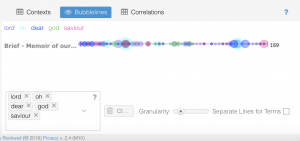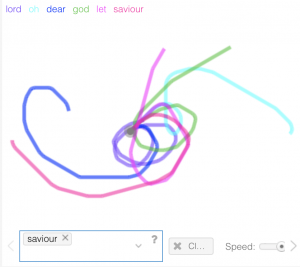The full transcription which I entered into Voyant had a total of 3,807 words with 796 unique word forms. There are an average of 1,269 words per sentence. Visualization tools like Voyant make texts much more understandable. Our Moravian memoirs were challenging to grasp, and so using Voyant helped me greatly. Voyant allowed me to interact with the text in a new way and helped me to answer our research question of how religion and faith play a role in Samuel Tippet’s transcription. The Cirrus word cloud and the Corpus Terms allowed me to view the frequency of words in the text. The most frequent words in the corpus are heart, times, time, poor and love. The Cirrus word cloud presents frequently used words in larger text for emphasis. This is a practice of spatial reading, which I found to be very helpful. Seeing texts in visual form allowed me to view the text more clearly. As Whitley explains, “such visualizations help us to perceive patterns in data that we might otherwise miss” (187). The Corpus Terms provided me with data that showed exactly how many times each word was used in the document. It was interesting to see that the word “heart” was used 31 times and that “Jesus” was used 13 times. These tools exposed the very religious nature of the text. “You find your perspective broadened through a series of unexpected discoveries” (185). Through Voyant, I was able to participate in Distant Reading, a concept explained in the Whitley text. Through Distant Reading, I was able to make connections and see the greater picture rather than closely reading every text and miss important aspects of the memoir. I might not have been able to draw such conclusions about Tippet’s memoir through reading it plainly without Voyant. These tools “challenge us to read texts differently than we otherwise would” (186). The bubble tool shows the key words which are most frequently used as the ones with biggest bubbles which makes it easy to visualize rather than reading terms off of a list. I like the visualization tools because they allow me to understand the information better.
Tippet was born in 1711 in the Parish of Bitton. He discusses his struggles in his family life. His father died when he was quite young, and he relied on God to get him through this massive loss. It seems that he is troubled and due to some dark statements throughout the piece. He mentions that he, “wishes he was never born”. He criticizes himself extensively and describes his reliance on God in order to move past issues in his earlier life. By asking ourselves the question of ‘how does religion and faith play a role in Samuel Tippet’s transcription’ we are able to analyze and understand the writing better. This question also helped us to compare Samuel Tippet’s memoir to Esther Latrobe’s memoir. For the Esther Latrobe memoir, the key terms were lord, dear, god, let and savior which is why our research question on religion pertains to their piece as well. The key terms for the pieces combined are Lord,time, heart, dear, and oh. The many tools available in Voyant allowed me to analyze and understand these memoirs. Tippet’s memoir is much shorter than Latrobe’s. Latrobe’s memoir is a much longer piece with 8,460 words. Using some of the tools such as terms berry, tells the Voyant user that the word ‘God’ was used 26 times in the Latrobe memoir.
http://humn10001fa2018.courses.bucknell.edu/files/2018/09/voyant-screenshot1.pdf
http://humn10001fa2018.courses.bucknell.edu/files/2018/09/voyant-screenshot2.pdf
http://humn10001fa2018.courses.bucknell.edu/files/2018/09/voyant-screenshot3.pdf
Allison Butler is a sophomore at Bucknell University. She is from New York. She likes fashion and tennis.





